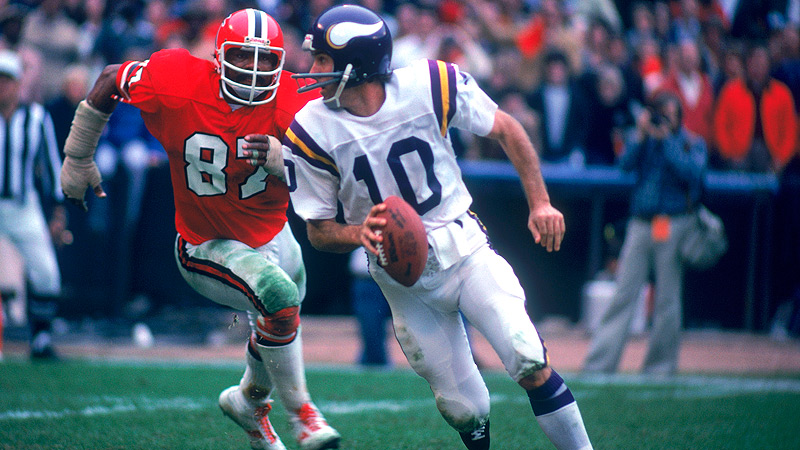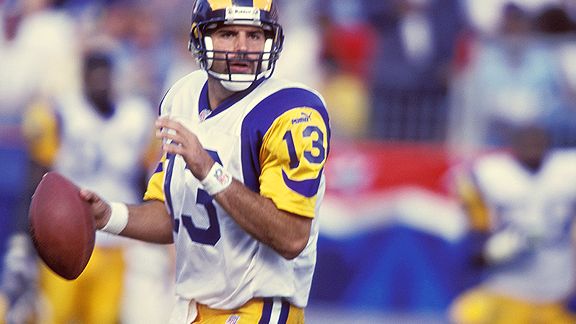20. Fran Tarkenton
Minnesota Vikings, 1961-1966; New York Giants, 1967-1971; Minnesota Vikings 1972-1978
 |
| AP Photo |
Tarkenton was drafted twice—first selected by the Boston Patriots in the fifth round of
the 1961 AFL Draft—then picked a month later by the Minnesota Vikings, an
expansion team, in the third round of the 1961 NFL Draft. The 21-year-old
Tarkenton signed with the Vikings and saw game action in the franchise’s first
ever contest, replacing ineffective veteran starter George Shaw. Despite coming
off the bench, Tarkenton accounted for five touchdowns—four passing TDs in a
250-yard debut and one rushing TD as the Vikings upset the Chicago
Bears in commanding fashion, 37-13. Tarkenton remains the only player in NFL
history to pass for four touchdowns in his first NFL game. He played for the
Vikings for the next six years, earning Pro Bowl honors in 1964 and 1966.
However, he butted heads with head coach Norm Van Brocklin, who disparaged the
idea of a mobile QB. Brocklin wanted a traditional pocket passer, making an
eventual divorce between the coach and QB inevitable.
The
Vikings traded Tarkenton and his uncanny scrambling abilities to the New York
Giants in 1967 for a pair of first-round and second-round picks. The swift
“Frantic Fran” brought the cellar-dwelling Giants (who went 1-12-1 in previous
year) back to respectability in his five-year tenure in New York. In his first
game as a member of the Giants, he threw two fourth quarter TDs to complete a
comeback victory over his former team, 24-23. The Giants finished the season at
the .500 mark, a year after posting the league’s worst record. Tarkenton made
the Pro Bowl with the Giants in his first four seasons with the Giants (1967-1970),
but was unable to lead the franchise to any postseason action (the team fell
just shy of reaching the playoffs in 1970 with a 9-5 record).
With Brocklin long gone, the Vikings traded back for Tarkenton in 1972 via another blockbuster
deal that cost Minnesota their All-Pro receiver Bob Grim, three-time Pro Bowl
QB Norm Snead, rookie Vince Clements and a
1st-round choice in ‘72 and ‘73. In his second stint with the Vikings, he made
three Pro Bowls (1974-1976) and won the MVP award in 1975, a year in which he
registered 2,994 passing yards and 25 TDs versus 13 interceptions in a 12-2
campaign for Minnesota.
In his final seven years with the Vikings
(1972-1978), “The Mad Scrambler” led Minnesota to six NFC Central Division
titles and three Super Bowl appearances. He lost all three Super Bowls he
played in, failing to attain the coveted NFL title that eluded him throughout
his entire career.
Over the 18 seasons he spent in the NFL,
Tarkenton threw for 47,003 yards (8th all-time) and 342 touchdowns
(6th most in NFL history). On the ground, he amassed 3,674 rushing
yards and 32 touchdowns.
19. Bob Griese
Miami Dolphins,
1967-1980
 |
| Via NFL.com |
Selected No.1 overall by the AFL’s Miami Dolphins in 1967, Griese enjoyed a brilliant
rookie season in which he threw for over 2,000 yards with 15 touchdown passes.
He was named to the AFL All-Star team in each of his first two years in the
league. The Dolphins—an expansion franchise established in 1966—struggled in
all three of the years Griese spent in the AFL, posting a dismal 12-28-2
record.
The Dolphins’ fortunes changed with the AFL-NFL merger in 1970. The club hired Don
Shula, who netted three NFL Coach of the Year honors and an NFL championship in
his tenure with the Baltimore Colts. Shula continued his legacy in Miami,
developing Griese into an elite signal caller. The Dolphins reached the
playoffs for the first time in their short history in Shula’s inaugural year
with the club, winning 10 of their 14 contests in 1970 as Griese made the Pro
Bowl.
In
the 1971 NFL season, Griese—a Pro Bowler and AP First-Team All-Pro—led the
Dolphins to Super Bowl VI, but fell flat 24-3 at the hands of the Dallas Cowboys.
The
Dolphins completed the only perfect season in NFL history in 1972 under the helm of Griese and
Shula. Griese was sidelined for much of the team’s immortalized season. He broke
his leg in Week 5 against San Diego, but miraculously returned for the AFC
Championship game versus the Pittsburgh Steelers. He was the man under center
for the Super Bowl VII victory, defeating the Washington Redskins 14-7.
Repeating
as champions in 1973, Griese and CO. cruised to a 12-2 record in the regular
season, before throttling all three opponents they faced in the playoffs. The
Dolphins won the AFC Divisional Round 34-16 over the visiting Bengals, before
dispatching the Oakland Raiders 27-10, en route to the Dolphins’ 24-7 win over
the Vikings in Super Bowl VIII.
The
Dolphins reached the postseason three times in the final seven years of Griese’s career from 1974-1980, failing to return to the Super Bowl or even the AFC
Championship again.
By career's end, Griese tallied two AFL All-Star appearances, six trips to the Pro Bowl and got the nod from the Associated Press for First-All Team twice (1971,
1977). The two-time Super Bowl Champion compiled 25,092 yards and
192 TDs through the air and 994 yards and seven TDs on the ground.
18. Kurt Warner
St. Louis Rams, 1998-2003; New York Giants, 2004;
Arizona Cardinals, 2005-2009
 |
| Al Messerschmidt/Getty Images |
Kurt
Warner’s rise to greatness is a tale of perseverance. After being released from
the Green Bay Packers’ practice squad in 1994, Warner opted to work at a
grocery store. Following a year of bagging groceries, the indomitable QB took
his talents to the Arena Football League to play for the Iowa Barnstormers.
Warner, an unstoppable force for the Barnstormers from 1995-1997, transitioned
to “NFL’s Europe” to play for the Amsterdam Admirals. There, he caught the eye of
various league scouts, particularly the St. Louis Rams, who signed the
27-year-old QB.
Finally inked to an NFL deal,
Warner knew he needed to make the most of this precious opportunity. He was
buried in the depth chart as the third-string QB for his rookie season in 1998,
but an injury to starting QB Trent Green in 1999 provided Warner the desired
opening to showcase his talents. Warner threw TDs in each of his first three
starts, a feat that no other QB in NFL history has accomplished. Warner was far
from finished after three stellar outings. He orchestrated one of the most
prolific seasons by a QB in NFL history, throwing for 4,353 yards with 41
touchdown passes and a completion rate of 65.1%. Warner won the 1999 NFL MVP, and was also named MVP of Super Bowl XXXIV as St. Louis defeated the
Tennessee Titans, 23-16, to secure the franchise’s first title since the Los
Angeles Rams were crowned champions in 1951.
The Rams high-octane offense—deemed “The
Greatest Show on Turf”—mustered three consecutive 500-point seasons (1999-2001),
an NFL record. Fresh of a Super Bowl victory, Warner had an electrifying start
to his 2000 season, registering 300 or
more passing yards in each of his first 6 games—tying Steve Young's record—throwing
for 19 touchdown passes in the process. A hand injury stifled Warner’s stretch
of triumph, sidelining him for five games that season.
After losing in the Wild-Card Round
the previous year, Warner directed the Rams back to the Super Bowl in the 2001
NFL season. Crowned MVP for a second time, Warner accumulated 4,830 passing yards and 38 TDs
as the Rams claimed the NFL’s top record at 14-2. Warner came up just
short in his pursuit of a second championship ring, losing to the underdog New
England Patriots in Super Bowl XXXVI.
Nagging hand injuries shelved Warner
from 23 out of a possible 32 games from 2002-2003. Fearful that Warner’s best
days were behind him, the Rams cut their Super Bowl winning QB in the onset of
the 2004 offseason in favor of Marc Bulger.
That same offseason the New York Giants signed Warner—just
months after trading for the top pick in the 2004 NFL Draft to select Eli
Manning. Warner was given the job to start the season, but was yanked by head
coach Tom Coughlin after two consecutive losses in the middle of the year that brought the team to a
pedestrian 5-4 record. Under Manning, the Giants won just one of their final
seven contests.
Signed by the Cardinals the ensuing
offseason, Warner achieved decent success in his first two years with the club.
However, it was not until the 2007 season—the year Warner bypassed first-round
pick Matt Leinart for the starting gig—that the two-time MVP returned to
stardom. Warner had 27 TD passes in 2007, one shy of the Cardinals franchise
record.
A Pro Bowl campaign came next for
Warner, who recorded a 96.9 passer rating with 30 touchdowns versus just 14
interceptions in 2008. Warner led the Cardinals to the franchise’s first
playoff appearance since 1998, also securing the team’s first division title in 33
years.
Despite losing in heartbreaking
fashion in Super Bowl XLIII to the Pittsburgh Steelers, Warner was able to again demonstrate why he is one of the most clutch QBs in league history.
In the 27-23 defeat, Warner threw for 377 yards (the 2nd-highest total in Super
Bowl history), completed 72.1% of his passes and had a quarterback rating of
112.3.
In his final season in the NFL,
Warner helped the Cardinals earn consecutive trips to the playoffs for the
first time since 1974-1975. Facing the Jacksonville Jaguars in Week 2, Warner broke
the NFL’s single-game record for completion percentage in a regular season game
with a 92.3 mark, completing 24 of 26 passing for 243 yards and two touchdowns
as he topped the previous league record set by Vinny Testaverde in 1993. A Week
16 win over the Rams witnessed Warner become only the second
quarterback in NFL history to throw 100 touchdown passes with two different
teams—joining Tarkenton in that regard.
In his final home playoff game, Warner dazzled the Cardinals’ fans with a remarkable outing, throwing more TDs
(5) than incompletions (4) in the club’s thrilling 51-45 victory over the Green
Bay Packers in the Wild-Card Round. Warner finished the game with the second-highest quarterback rating (154.1) in NFL playoff history. With the win, Warner finished his career with a 7-0 career
home playoff record. Warner and the Cardinals were forced to travel to the
SuperDome the following weekend, losing to the eventual Super Bowl Champion New
Orleans Saints in his final NFL game.
No comments:
Post a Comment